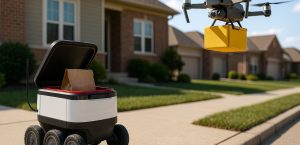Food delivery has become one of the most dynamic and competitive industries in recent years. From the boom of e-commerce to the rise of platforms like Uber Eats, DoorDash, and Rappi, the last mile in the food sector faces the challenge of combining speed, freshness, and cost efficiency. In this landscape, robotics has emerged as a disruptive force that is radically transforming how meals reach customers.
Both autonomous ground robots and delivery drones are no longer futuristic concepts: in several countries, these technologies are already in pilot programs or active commercial use, ushering in a new logistics era. The promise is clear: faster deliveries, greater efficiency, lower environmental impact, and the ability to overcome the challenges of traffic congestion and urban density.
The Last-Mile Challenge in Food Delivery
The last mile is widely regarded as the most expensive and complex stage of logistics. In food delivery, the stakes are even higher because of unique requirements:
- Speed: customers expect their food in minutes, not hours.
- Quality preservation: meals must arrive fresh, hot, and properly presented.
- Low costs: delivery apps operate on slim margins, so every second and mile count.
- Urban adaptability: traffic congestion and restricted zones often limit traditional motorcycles and bicycles.
Robots and drones provide viable alternatives, cutting costs, boosting speed, and meeting rising consumer expectations.
Ground Robots: Small Vehicles, Big Impact
Delivery robots are small, self-driving vehicles that move along sidewalks or bike lanes to bring orders directly to the customer’s door. Companies like Starship Technologies, Kiwibot, and Amazon Scout are leading this innovation.
Key advantages:
- Lower operational costs: no reliance on human couriers reduces expenses.
- Contactless delivery: ideal in the post-pandemic context, where health and safety remain a priority.
- Urban accessibility: effective in campuses, gated communities, or short-distance routes with limited vehicle access.
- Sustainability: electric-powered robots have a much smaller carbon footprint.
Current limitations:
- Legal restrictions in many cities on robot circulation.
- Slow speeds (3–6 km/h), making them best for short distances.
- Need for remote supervision when facing unexpected obstacles.
Drones: The New Dimension of Delivery
Logistics drones may represent the most disruptive innovation in food delivery. Companies like Wing (Alphabet/Google), Amazon Prime Air, and Zipline have already completed thousands of deliveries in the U.S., Europe, and Africa.
Key benefits:
- Unmatched speed: drones can complete trips in minutes that would take much longer on the ground.
- Access to remote areas: ideal for rural communities or regions with limited infrastructure.
- Reduced urban traffic: operating in the air eliminates congestion delays.
- 24/7 operations: drones aren’t constrained by traffic or human limitations.
Remaining challenges:
- Airspace regulations: adoption depends on each country’s evolving policies.
- Limited payload capacity: most drones carry between 2 and 5 kg, enough for small food orders.
- Safety and privacy concerns: accidental crashes or onboard cameras in residential areas.
A New Era in Customer Experience
Robotics is not only about efficiency it’s also transforming the customer experience:
- Greater reliability in delivery times, less affected by traffic or human factors.
- Innovative interactions, where receiving food from a robot or drone adds novelty and brand differentiation.
- Real-time tracking, with integrated systems that keep customers updated every step of the way.
For food delivery, where immediacy is essential, these technologies could become a major competitive advantage.
Implications for Restaurants and Local Providers
The integration of robots and drones impacts not only global platforms but also restaurants and local delivery providers:
- Restaurants may reduce costs by joining autonomous delivery networks instead of relying solely on app-based couriers.
- Local delivery companies must adapt, either by offering hybrid models (robots + human couriers) or by adopting their own tech.
- The food supply chain will become more precise, with reduced waste and improved inventory control thanks to faster delivery cycles.
Conclusion
Ground robots and drones are redefining how we think about food delivery logistics. While regulatory and technical challenges remain, their advantages in speed, cost savings, and sustainability position them as the future of last-mile delivery.
What today seems like a novelty on college campuses or suburban neighborhoods may soon become a standard feature of urban life. For customers, it means fresher, faster meals; for restaurants and suppliers, a more competitive supply chain; and for the industry, the dawn of a new era where robotics moves from science fiction into everyday reality.




